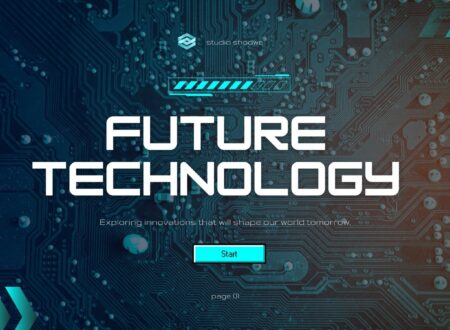Introduction to the Digital Landscape
The digital landscape is evolving at an unprecedented pace. As technology advances, it shapes the way we live and work. From smartphones to smart homes, every corner of our lives feels its impact. Understanding these shifts is crucial for anyone looking to thrive in this fast-changing environment.
Whether you’re a business owner navigating new challenges or an individual eager to keep up with trends, staying informed can make all the difference. In this blog post, we’ll explore five essential technology trends that are reshaping our world today and will continue to do so in the future. Get ready to embark on a journey through innovation and discovery as we navigate the exciting terrain of modern technology together!
Trend #1: Artificial Intelligence (AI) and Machine Learning
Artificial Intelligence and Machine Learning are transforming how we interact with technology. These advancements enable systems to learn from data, making them smarter over time.
AI is not just for tech giants anymore. Small businesses are leveraging AI tools to streamline operations and enhance customer experiences. Chatbots, personalized recommendations, and predictive analytics are becoming commonplace.
Machine learning algorithms analyze vast amounts of data quickly. They identify patterns that humans might miss, offering insights that drive better decision-making.
As these technologies evolve, they open doors to new possibilities across various industries—from healthcare to finance. The potential applications seem limitless as AI continues to advance.
However, the rise of intelligent machines also raises ethical questions about privacy and job displacement. Balancing innovation with responsibility will be crucial in shaping the future landscape of work and society.
Trend #2: Internet of Things (IoT)
The Internet of Things (IoT) is changing how we interact with our surroundings. Smart devices are becoming commonplace, connecting homes, cars, and even cities to the internet. This interconnectedness allows for seamless communication and automation.
Imagine a world where your refrigerator can suggest recipes based on its contents or your thermostat adjusts itself according to your preferences. These innovations enhance convenience and efficiency in daily life.
Businesses are also leveraging IoT to optimize operations. Sensors track inventory levels in real-time, ensuring that supply chains run smoothly without interruptions.
Moreover, smart cities use IoT technology to manage traffic flow and reduce energy consumption. The potential applications seem endless as more devices come online each day.
As this trend evolves, staying informed about new developments will be vital for individuals and organizations alike. Embracing the possibilities of IoT can lead to significant advantages in both personal life and professional settings.
Trend #3: Virtual and Augmented Reality
Virtual and Augmented Reality (VR and AR) are transforming how we interact with digital content. These immersive technologies create experiences that feel incredibly real, bridging the gap between the physical and digital worlds.
In various sectors like gaming, education, and healthcare, VR offers unique training simulations. For example, medical students can practice surgeries in a safe environment. Meanwhile, AR enhances our reality by overlaying information onto our surroundings. Think of navigation apps that project directions right onto city streets.
Businesses are leveraging these technologies for marketing as well. Imagine trying on clothes or makeup virtually before making a purchase decision; it’s not just futuristic—it’s becoming commonplace.
As VR and AR continue to evolve, their potential applications seem limitless. They encourage creativity while engaging users in ways traditional media simply can’t match. The future is vivid, interactive, and undeniably exciting.
Trend #4: Cybersecurity and Data Privacy
As the digital realm grows, so do threats to our data. Cybersecurity has become a priority for businesses and individuals alike. Data breaches can lead to devastating consequences, from financial loss to reputational damage.
The demand for robust cybersecurity measures is soaring. Companies are investing in advanced technologies like AI-driven security systems that proactively detect and neutralize threats before they escalate.
Data privacy regulations are also tightening globally. Consumers now expect transparency regarding how their information is collected and used. This shift compels organizations to adopt practices that prioritize user consent and data protection.
Cyber hygiene is essential in this landscape. Simple actions, such as using strong passwords or enabling two-factor authentication, can significantly reduce vulnerabilities.
Organizations must keep pace with evolving security protocols while fostering a culture of awareness among employees about potential risks lurking online.
Trend #5: Cloud Computing
Cloud computing has changed the way businesses operate. It offers flexibility and scalability like never before. Companies can access their data from anywhere, anytime.
This technology eliminates the need for extensive on-site infrastructure. Instead of investing in servers and storage, organizations can pay for what they use. This results in significant cost savings.
With cloud services, collaboration becomes seamless. Teams spread across different locations can work together effortlessly on projects. Tools are easily accessible and updates happen automatically.
Security is also a major focus for cloud providers today. Advanced encryption techniques help protect sensitive information against breaches. This gives users peace of mind as they navigate this digital landscape.
As more companies embrace remote work, cloud computing will continue to evolve. Its role in ensuring business continuity cannot be overstated. The future looks bright with endless possibilities ahead.
How These Trends Will Impact Businesses and Individuals
The emerging technology trends are reshaping the way businesses operate. Companies utilizing AI and machine learning can streamline processes, enhance customer experiences, and make data-driven decisions faster than ever.
For individuals, these advancements mean increased personalization in services. From tailored shopping recommendations to smart home devices that learn your preferences, everyday life becomes more convenient.
IoT is connecting everything from appliances to cars. This interconnectedness allows for smarter living but also raises questions about security and privacy.
Cybersecurity measures become crucial as businesses gather more data. Individuals must stay vigilant while navigating digital platforms to safeguard personal information.
Cloud computing supports remote work environments by providing seamless access to resources from anywhere. This flexibility benefits companies looking to adapt quickly in an evolving market landscape while empowering employees with greater autonomy over their workspaces.
Preparing for the Future: Steps to Stay Ahead in the Digital Landscape
To thrive in the ever-evolving digital landscape, proactive preparation is key. Start by continuously upskilling yourself and your team. Embrace online courses or workshops that focus on emerging technologies.
Networking plays a crucial role too. Engage with industry professionals through social media platforms like LinkedIn or join local tech meetups to share insights and ideas.
Stay informed about technological advancements by following credible sources and thought leaders in your field. Regularly reading blogs, articles, and whitepapers can broaden your perspective.
Implement flexible strategies within your organization. This adaptability will help you pivot quickly as new trends emerge.
Invest in robust tools that enhance productivity and collaboration among teams. The right technology can make all the difference in maintaining a competitive edge in this fast-paced environment.
Conclusion
Navigating the digital landscape requires awareness and adaptability. The technology trends shaping our world are not just buzzwords; they represent fundamental shifts in how we live and work.
Artificial Intelligence and Machine Learning continue to revolutionize industries, automating processes, enhancing decision-making, and improving customer experiences. As businesses leverage these technologies, individuals will find new ways to interact with products and services tailored specifically for them.
The Internet of Things connects devices in unprecedented ways. This integration creates smarter homes and workplaces but also raises questions about data security. Understanding this connectivity is crucial for both consumers and companies aiming to innovate responsibly.
Virtual Reality (VR) and Augmented Reality (AR) offer immersive experiences that can transform education, training, entertainment, or even real estate. These technologies have moved beyond gaming into practical applications that enhance engagement across various sectors.
As reliance on digital platforms increases, so does the need for robust cybersecurity measures. Data privacy has become paramount as users demand transparency from organizations regarding their personal information’s use.
Cloud computing continues to change the way businesses operate by providing scalable resources without heavy investments in physical infrastructure. This flexibility allows companies of all sizes to compete more effectively in a global marketplace while ensuring seamless access to essential tools regardless of location.
To stay ahead amidst these evolving trends requires proactive planning: invest in continuous learning about emerging tools; foster a culture of innovation within your organization; implement stringent cybersecurity protocols; explore collaborations that leverage cloud capabilities effectively.
Staying informed about these developments offers valuable insights into future opportunities while mitigating challenges posed by rapid technological advancements. Embracing change rather than resisting it will empower you—both personally and professionally—in this dynamic environment where adaptation is key.





